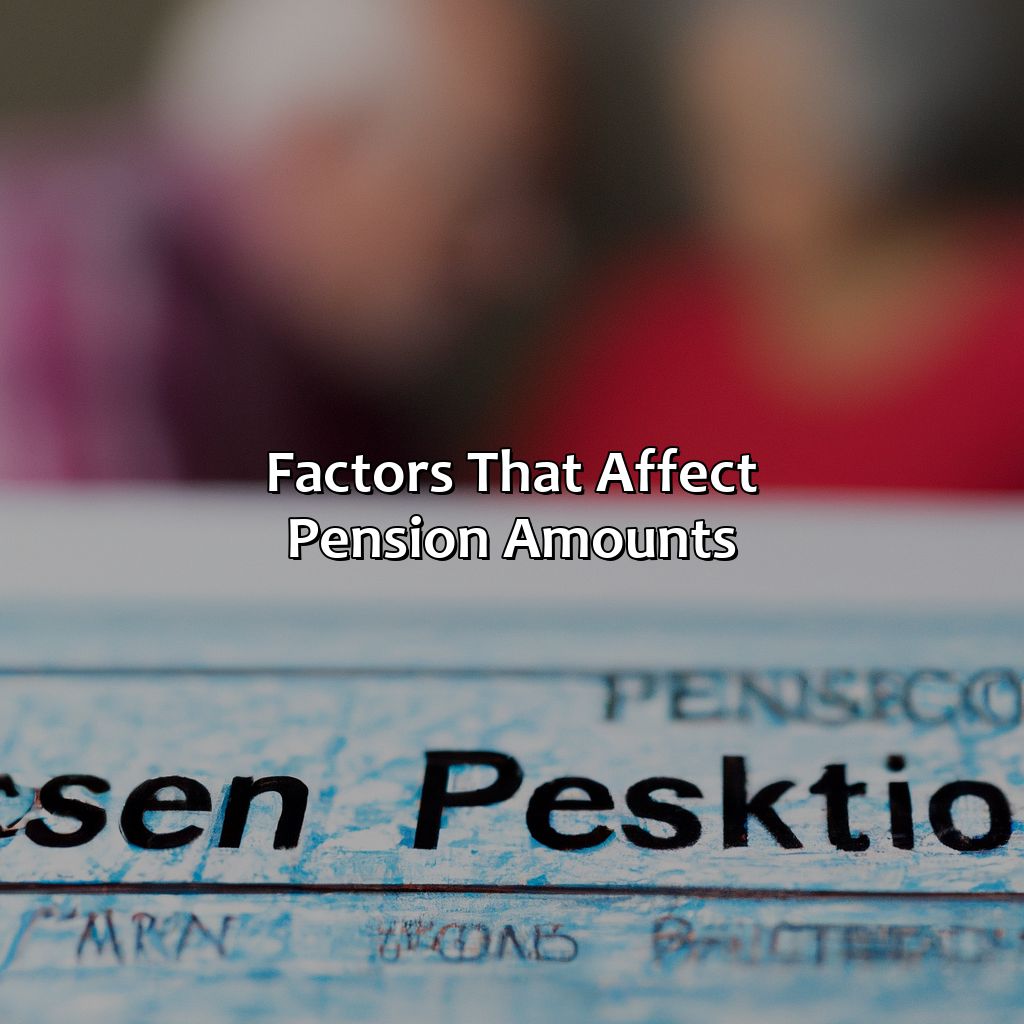How Much Is The Pension In The Usa?
Key Takeaway:
- There are three main types of pensions in the USA: Social Security, employer-sponsored pensions, and individual retirement accounts (IRAs). It is important to understand the differences between them and plan accordingly.
- The amount of pension benefits you receive is determined by various factors, including the formula used to calculate benefits, the age of retirement, length of service, and salary history.
- The average pension amounts in the USA vary by type, with Social Security benefits averaging around $1,500 per month, median income from pensions around $9,262 per year, and average retirement savings balances around $92,000. However, it is important to note that individual experiences may vary widely.
You’ve worked hard throughout your life and now it’s time to enjoy the rewards of a secure retirement. But do you know how much is the pension in the USA? Read on to find out and make sure your golden years are worry-free.
Types of pensions in the USA
Be informed of the USA’s pension types. To know the solutions for Social Security, employer-sponsored pensions and IRAs. Each offers unique advantages and obstacles. When setting up your retirement, bear these in mind.

Image credits: retiregenz.com by David Arnold
Social Security
The US government provides a program to its citizens that offers financial assistance known as Social Security. It offers retirement, disability, and survivor benefits based on the individual’s work history and contributions. The program is funded through payroll taxes and is administered by the Social Security Administration.
Furthermore, to be eligible for Social Security benefits, an individual must have earned enough credits by working and paying into the system for at least ten years. The amount an individual receives in retirement benefits depends on their lifetime earnings record. You can check how much SSS pension you will get through their online calculator.
Supplemental Security Income (SSI) is also available for individuals who are disabled or have low income and assets. SSI provides monthly cash payments to help with basic needs such as food, shelter, and clothing.
Additionally, beneficiaries may also receive Medicare coverage once they turn 65 years old or if they have certain disabilities regardless of age.
In a report by AARP, it was found that about half of older Americans rely on Social Security for at least half of their income during retirement.
Finally, a reason to pretend to like your boss – employer-sponsored pensions!
Employer-sponsored pensions
Employer-provided retirement plans are crucial for a comfortable post-retirement life. These retirement benefits come in various forms such as defined benefit, defined contributions, and cash balance pensions. Defined benefits schemes offer predetermined payouts based on a set formula, whereas defined contributions allow employees to contribute a fixed amount into their accounts. Cash balance plans combine features of both.
It is worth noting that employer-sponsored plans vary significantly by industry, company size, and demographics of the workforce. Several factors affect pension payouts, including length of service, age at retirement and salary history. Therefore, it is essential to understand your organization’s retirement plan and know how many years you have to work in Canada to get a pension and work with your financial advisor.
Employers may also offer additional savings vehicles like 401(k)s or profit-sharing plans to help supplement workers’ pensions or match employee contributions. Knowing about all available investment alternatives can ensure a secure financial future.
In today’s unpredictable times where Social Security will not be enough to cover all living expenses in retirement, having access to an employer-sponsored pension scheme is critical. Take advantage of all payroll deductions available for savings purposes; failing this would result in missed opportunities for adequate financial security later in life.
Save for retirement with an IRA, because living off your kids’ inheritance is just bad form.
Individual retirement accounts (IRAs)
One of the common types of retirement accounts in the USA is personalized retirement accounts. They are popularly known as Individual Retirement Accounts (IRAs). These accounts are set up by an individual to save for their post-retirement years.
The IRAs offer a tax-advantaged way to invest money for retirement specifically, unlike employer-sponsored plans such as 401(k)s or pensions. There are two main types of IRAs: traditional and Roth. With traditional IRAs, investors take tax deductions on contributions, and money grows tax-deferred until that person retires and withdraws funds. On the other hand, Roth IRA accounts allow you to contribute after-tax dollars with no deduction but then withdraw funds without having to pay taxes on them.
Notably, investing early is a smart move; it permits capital appreciation over time while safeguarding from income taxes. Moreover, paying attention to asset allocation is also vital. It boosts remunerations potential while counteracting risks by varying investments within your portfolio.
To increase retirement savings through IRAs, one can consider setting automatic contributions, maximizing catch-up contributions if they’re over 50 years old, and choosing low-cost investments like simple index funds or exchange-traded funds (ETFs). By doing so gradually over time and taking full advantage of the perks which come attached to IRA accounts will eventually bring stability in life after work ends.
Calculating pension benefits is like trying to solve a Rubik’s cube blindfolded, while riding a unicycle, and being chased by a swarm of bees.
How pension benefits are calculated
To figure out pension benefits, you must know some formulas. Calculate the benefits with ‘How pension benefits are calculated’ and its sub-sections:
- Social Security benefits formula
- Defined benefit pension plan formula
- Defined contribution plan formula
These formulas have variables that can influence the benefit amount you get.

Image credits: retiregenz.com by James Washington
Social Security benefits formula
The calculations for Social Security benefits are determined by a formula based on the individual’s earnings over their working life. This formula considers the highest 35 years of earnings, adjusts for inflation, and applies a progressive benefit formula to arrive at the final benefit amount. The more an individual earns during these 35 years, the higher their benefits will be. Additionally, individuals who delay claiming until after their full retirement age can receive higher monthly benefits.
One important factor to consider is that Social Security benefits do not replace all of a person’s pre-retirement earnings but rather act as a source of supplemental income. To maximize one’s Social Security benefits, it is crucial to plan ahead and make informed decisions about when to start receiving payments.
Pro Tip: Consult with a financial advisor or use online calculators to estimate your retirement income sources and determine your optimal claiming strategy.
When it comes to calculating pension benefits, it’s like figuring out the secret formula to a soft drink- except this one doesn’t give you a sugar rush, just a retirement one.
Defined benefit pension plan formula
For those curious about how the calculation process of a Defined Benefit Pension Plan works, here’s some information.
To provide an overview, the formula typically includes three essential elements: a percentage of the participant’s salary, the number of years they worked and a multiplier factor. The benefit amount will increase if any of these components increase. If you’re wondering what is the average pension for a nurse, you can use this formula as a starting point.
Below is a table describing how each variable affects pension benefits:
| Variable | Effect On Benefit Calculation |
|---|---|
| Percentage of Salary | Higher percentage leads to higher benefit |
| Years Worked | More years lead to higher benefit |
| Multiplier Factor | Decided by plan and can vary |
It’s important to note that not all pension plans are created equal due to variations in the formula. Additionally, many companies have changed or eliminated defined benefit plans in recent years due to financial reasons.
One unique detail about DB plan formulas is that some may offer early retirement options for participants who are close to their required amount of years worked.
A fascinating piece of history about pensions is that during World War II, pensions became popular among employers as wage freezes were instituted by the government. Employers substituted pensions as an attraction for potential employees since wages couldn’t be raised.
Calculating your retirement fund is a lot like a game of Jenga – one wrong move and it could all come crashing down, but with a defined contribution plan formula, you can stack the odds in your favor.
Defined contribution plan formula
In a defined contribution retirement plan, the formula for calculating benefits involves different variables. The amount of money contributed by both the employee and the employer over time, the investment performance of those contributions, and any fees or expenses associated with managing the plan are all factors that determine pension benefits.
To further elaborate on the calculation process of a defined contribution plan, we can create a table to showcase the various contributions made. The table may consist of columns such as monthly employee contributions, annual employer contributions, total contributions, investment return percentage, and total balance accumulated over time.
Moreover, in addition to these variables mentioned before, age and time spent contributing also play crucial roles in determining retirement benefits. The longer an individual contributes to their retirement account and the later they retire, results in more substantial financial gains.
It is essential to ensure that a retirement portfolio is managed efficiently to produce substantial profits. A poorly managed investment may result in degrading returns that could significantly impact one’s retirement funds.
Ultimately, it is crucial to recognize the importance of planning for retirement as early as possible. In doing so, individuals can contribute towards their pension funds strategically and invest intelligently. This can lead to long-term stability securely funded retirements without stressful financial liabilities. Wondering how much is an average pension in the USA?
For instance, Jennifer started contributing monthly towards her 401(k) from her first job at twenty-two years old. After fifteen years of consistency in her contributions and smart investing strategies advised by her company’s financial planner consultant service subscribers’ group (FPCSSG) team led Jennifer to secure solid eight-figure retirement savings at early retirement age forty-five years old!
Why save for retirement when you can just become a professional TikTok dancer? Oh wait, never mind, average pension amounts in the USA are actually kind of depressing.
Average pension amounts in the USA
Discovering the norm for pension amounts in the USA? Look no further! Investigate the subsections of:
- Social Security benefits average
- Median income from pensions
- Average retirement savings balance
These three pieces have a major role in the pension amount that people get in the US.

Image credits: retiregenz.com by Yuval Arnold
Social Security benefits average
The average payout for retirement benefits in the USA varies depending on several factors, including an individual’s employment history. The Social Security Administration determines average monthly payouts based on benefit claims and other information, which is made available to the public.
In recent years, the average annual Social Security retirement benefit has been around $18,000. Many individuals may receive more or less than this amount based on several factors, including their earnings record and overall work history. It’s worth noting that these payment amounts typically increase each year with cost-of-living adjustments.
While Social Security benefits can provide crucial financial support during retirement, it’s important to understand that they are just one aspect of a comprehensive retirement plan. Planning ahead and investing in additional sources of income, such as private pensions or personal savings accounts, can ensure a comfortable and secure financial future. Learn more about how long a pension can last and plan accordingly.
Don’t miss out on maximizing your potential retirement benefits by planning ahead now. Speak with a financial advisor to explore your options and develop a personalized strategy for achieving your retirement goals.
When it comes to pension income, median is just a fancy word for middle-of-the-road.
Median income from pensions
The average amount of money individuals receive from their pension plans is a topic of interest. Let’s take a closer look at the “Median income from pensions” to better understand the financial situation of retirees in the USA.
A table showcasing “Median income from pensions” provides valuable insights. According to research, the average monthly pension payment in the US is $1,471. The table also indicates that 21% of retirees have less than $1000 in savings.
Additionally, it’s important to note that there are gender and socio-economic disparities in pension amounts. For instance, women and people earning less money tend to receive smaller pensions than their counterparts. If you are a widow wondering how much your pension will be, it’s best to consult with a financial advisor.
It’s vital to plan for retirement properly as social security benefits and pensions alone may not be sufficient to cover expenses. Take action now to secure your future and avoid missing out on potential opportunities in retirement.
Retirement savings balance? More like ‘How many years can you survive on ramen noodles?’
Average retirement savings balance
The typical accumulation of funds for retirement in the US is a vital topic that needs thorough discussion. As per recent studies, the mean balance for retirement savings accounts is $95,600. This figure varies depending on individual factors such as income, age, and employment status.
Moreover, it is essential to highlight how factors like employer contributions and investment strategies influence one’s retirement balance. Planning for the future is crucial regarding retirement funds. It involves making prompt financial decisions such as starting to save early and adjusting saving habits. If you’re curious about how much is pension in UK, do your research and start planning early.
Implementing proper investment strategies such as keeping expenses low and diversifying investment portfolios can significantly impact one’s accumulated amount at retirement. By understanding these strategies, every individual can take control of their financial destiny when they retire.
Your pension amount may depend on factors like your career success or how lucky you were in avoiding those pesky workplace accidents.
Factors that affect pension amounts
In the USA, to know how much pension you’ll get, there are several factors you must take into account. To work out your possible pension income, you must think about age of retirement, duration of service, and salary history.
In this part, all three of these important aspects will be investigated closely, to aid you in organizing your retirement.

Image credits: retiregenz.com by Adam Washington
Age of retirement
The retirement age is a major factor that affects the amount of pension one can expect to receive in the USA. Usually, the earlier you retire, the lower your pension benefits will be. This is because Social Security calculates your monthly benefit based on your earnings history and age at retirement.
The reason behind this is that when you take your retirement benefits early, Social Security lowers the amount to account for expected expenses over more years than if you wait until full retirement age.
One fact that is commonly overlooked is that even if you decide to take your benefits early, Social Security still sets a “full retirement age” known as FRA, which can range from 66 or 67 years depending on when you were born. If you start receiving benefits prior to this FRA, there’ll be a permanent reduction in monthly payments.
Camila had been working as an accountant for over three decades when she decided to retire at 62-years-old. She was entitled to receive $1000 a month in regular retired worker’s social security benefit, but because she opted for early retirement; she received only $750 per month. Her reduced payment would still be in effect had Camila not remained employed after reaching full retirement age and had not accrued additional social security credits.
Are you wondering what is the maximum pension limit in the USA?
When it comes to pensions, the longer your service, the bigger your check – unless you’re a Kardashian, then you just need to post a selfie.
Length of service
The duration of one’s employment is a crucial factor in determining the pension amount. The longer the period of service, the higher the pension benefits will be.
The length of employment history significantly impacts one’s retirement income as pensions are generally based on years of service. It is important to note that different companies have different pension plans and eligibility requirements, so it’s essential to review your employment agreement thoroughly. Employers typically consider part-time work when calculating years of service, which means employees who work for less than 35-40 hours per week may still qualify for pension benefits.
Additionally, some employers offer incremental increases in pension benefits for each year served. For example, an employee who has worked for ten years may receive a lower percentage of their salary compared to someone who has worked for twenty-five or more years.
Interestingly, in 1889, the German states established non-contributory old age pensions for workers aged over 70 through paying annually from an initial fund consisting of individual contributions and subsidies from both employee and employer organizations alike and government agencies.
Paying into a pension is like investing in your future self, but with a less impressive return on investment than the lottery tickets you bought in your 20s.
salary history
The monetary compensation received throughout one’s career is what makes up an individual’s income history. This history is a critical component that impacts pension amounts later in life. An accurate and comprehensive salary history record allows retirees to receive a fair and reasonable pension amount, ensuring they don’t face financial challenges while they are retired.
The earning progression over time also determines the average lifetime earnings, making it essential to track all income sources accurately.
To know more about pension plans, you can check out how much Canada pension plan you will receive based on your earnings.
It’s crucial to ensure that all income figures are reported or included in the salary history, including part-time work, bonuses or incentives, pay raises, promotions or any other sources of earnings. Forgetting to include any relevant information could negatively impact the final payout amount at retirement age. A robust salary history record helps ensure complete data reporting and prevents potential errors during final calculations.
It is important to note that keeping the salary history up-to-date is critical for future benefits to employees. It’s advisable to maintain detailed compensation-related documents such as tax forms, employment agreements, pay stubs and W-2s as evidence of earnings throughout their working years. Regularly monitoring this information can help avoid discrepancies during calculations and benefit determination procedures used by employers and insurance providers.
To ensure maximum pension payouts at retirement age, maintaining an accurate Salary History report is vital for employees. They should keep track of various sources of income while updating the record regularly throughout their career. Maintaining detailed compensation evidence can also help in case of discrepancies during calculations by employers and insurance providers, reducing financial stress during retirement years significantly.
It’s important to know about What is Pension Income Splitting Canada? to understand how retirement benefits can be optimized.
Some Facts About Pension in the USA:
- ✅ The average monthly Social Security benefit for retired workers was $1,543 in January 2021. (Source: Social Security Administration)
- ✅ The maximum retirement benefit for someone who retires at full retirement age in 2021 is $3,148. (Source: Social Security Administration)
- ✅ To qualify for Social Security retirement benefits, you need to have earned at least 40 work credits, which is typically equivalent to 10 years of work. (Source: AARP)
- ✅ In addition to Social Security, some people may also receive a pension from their employer. (Source: Investopedia)
- ✅ The amount of pension you receive depends on factors such as your years of service, salary, and retirement age. (Source: U.S. Office of Personnel Management)
FAQs about How Much Is The Pension In The Usa?
How much is the pension in the USA?
The amount of pension in the USA depends on various factors like your age, salary, and length of service. You can check your Social Security Statement to get an estimate of your retirement benefits or use an online calculator to get an idea of your monthly pension.
What is Social Security?
Social Security is a federal program that provides retirement, disability, and survivor benefits to eligible individuals. It is funded by payroll taxes, and the benefits are based on your work history and contributions.
At what age can I start receiving my pension in the USA?
You can start receiving your pension in the USA as early as age 62, but if you start receiving benefits before your full retirement age, your monthly payment will be reduced. Your full retirement age depends on the year you were born.
Can I work while receiving my pension in the USA?
Yes, you can work while receiving your pension in the USA, but there are limits to how much you can earn before your benefits are reduced. The limits change every year, and if you earn more than the limit, your benefits will be reduced temporarily.
Are pensions taxable in the USA?
Yes, pensions are taxable in the USA. The amount of tax you will pay depends on your income, deductions, and tax bracket. You may be able to reduce your taxes by contributing to a tax-deferred retirement account like a 401(k) or IRA.
What happens to my pension if I die?
What happens to your pension if you die depends on the type of pension you have. If you have a defined-benefit pension, your spouse or designated beneficiary may be eligible for survivor benefits. If you have a defined-contribution pension like a 401(k), your beneficiaries will inherit the money in your account.
